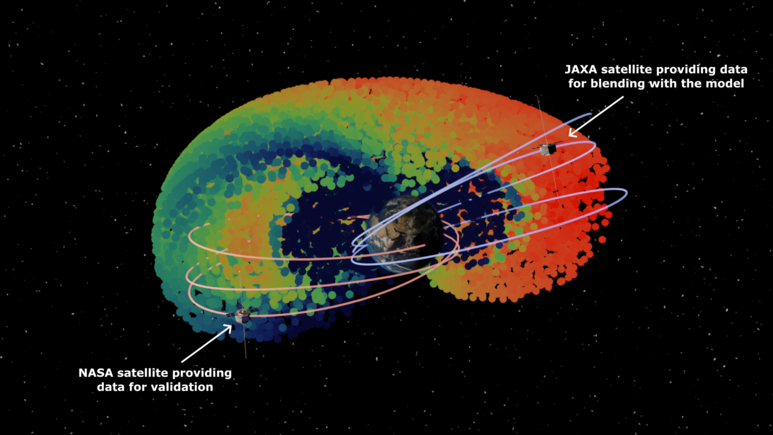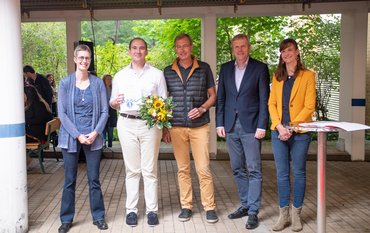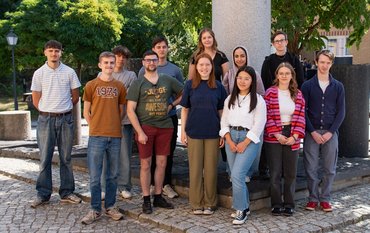Summary
In the era of a rapidly growing fleet of satellites in space, accurate prediction of space weather phenomena such as storm-like amplifications of electromagnetic fields and particle streams is essential to protect satellite infrastructure from damage and system failures. Just as the accuracy of weather forecasts on Earth depends on precise knowledge of current atmospheric conditions, predicting the weather phenomena of near-Earth space requires a deep understanding of the current state of the dynamic radiation belts surrounding the Earth. An international research team led by Bernhard Haas and Yuri Shprits from the GFZ German Research Centre for Geosciences has – together with the collaborative research centre “Data assimilation” (SFB 1294) at University Potsdam – used the example of a geomagnetic storm to show how the principle of data assimilation, which is very powerful in terrestrial weather forecasting, can be used for this purpose. This is a process that continuously determines a coherent overall initial state for further forecasts from a wealth of punctual real-time measurements, in this case by satellite, using physically based models. The study has been published in the journal Nature Scientific Reports.
Background: The necessity and challenge of space weather forecasting
The radiation belts and ring current that surround the Earth in space pose a threat to satellites: The charged particles flying there can cause temporary malfunctions or irreversible damage to electronic components through effects such as deep dielectric charging or surface charging. Geomagnetic storms, which amplify and "swirl" the particle streams, increase this risk. Timely prediction of such hazards can help satellite operators to protect their valuable equipment.
In order to be able to predict the particle streams around the earth as precisely as possible in terms of space and time, it is necessary to know the initial state as accurately as possible at all times. However, only selective measurements from a few specialised satellites are available for this purpose. The global picture must be calculated from these using models.
Progress has been made in the modelling and description of the ring currents. For example, a study published in June 2023 by GFZ researchers discovered a previously unconsidered loss mechanism of particles in the ring current that could significantly improve the accuracy of space weather forecasting. And physical models can already be used to visualise the basic dynamics of the ring current in geomagnetically quiet times.
"However, especially for highly dynamic events such as geomagnetic storms, global state descriptions in near real time are still a challenge," says Bernhard Haas, PhD student in the GFZ Space Physics and Space Weather section and first author of the study.
Transferring a method from meteorology: data assimilation
Haas and his team from the GFZ led by Yuri Shprits, head of the section and professor at the University of Potsdam, together with other researchers from the collaborative research centre “Data assimilation” (SFB 1294) at University Potsdam and from the USA and Japan, therefore utilised the advantages of so-called data assimilation. This method has already proven to be indispensable in meteorology, where even small uncertainties in the knowledge of the current state can lead to considerable errors in future forecasts.
Data assimilation refers to the merging of information from measurements and physical models. One underlying algorithm is, for example, the Kalman filter used in this study. In an iterative loop, the future state is constantly re-estimated on the basis of the currently available measurement data and the underlying physical model, including an indication of the associated uncertainty.
In the field of space weather forecasting, the assimilation of real-time data of particle fluxes provided by satellites is also a key to gaining insights into the current state of the space environment and performing analyses after extreme events such as geomagnetic storms.
Validation of the approach with data from a 2017 geomagnetic storm
While previous efforts to work with this approach could not be quantitatively validated due to limited amounts of data, the Van Allen probes of the US space agency NASA and the Arase satellite of the Japanese space agency JAXA offered the scientific community a unique opportunity to do so: Several highly specialised satellites orbited the earth at the same time. They were able to provide high-precision data on particle flows during the geomagnetic storm on 7 September 2017. The Van Allen probes were on the day side of the Earth, while Arase was on the opposite night side. This combination allowed the researchers to validate the results of the assimilation of data from one satellite by the other and to investigate the global response of the ring current during this event.
Resume
"The results of our study emphasise that data assimilation becomes a crucial tool in geomagnetic storms where the prediction of the dynamical system is difficult. The assimilation of measurements from a single satellite is sufficient to significantly improve the global model results. This challenges traditional assumptions in meteorology, where large amounts of data are often used for assimilation," resumes Bernhard Haas.
Yuri Shprits emphasises: "The ring current model operated at GFZ blends all available data with our state-of-the-art model and provides the most accurate reconstruction of the current state of the hazardous space environment and accurate predictions into the future. This research paves the way for a new type of predictions based on measurements that will help protect our most valuable assets in space."
Original study:
Haas, B., Shprits, Y.Y., Wutzig, M. et al. Global validation of data-assimilative electron ring current nowcast for space weather applications. Sci Rep 14, 2327 (2024). https://doi.org/10.1038/s41598-024-52187-0















![[Translate to English:] [Translate to English:] Abror Gafurov von dem Schriftzug "Welcome to Azerbaijan" und den UN und COP Logos](/fileadmin/_processed_/2/5/csm_2024_11_Baku_COP29_Abror_Gafurov_1042faec82.jpeg)


![[Translate to English:] Martin Herold standing in front of the library on the Telegrafenberg](/fileadmin/_processed_/c/d/csm_Martin_Herold_d385ee4dd9.jpeg)
![[Translate to English:] Many people are listening to a presentation in the GFZ lecture hall.](/fileadmin/_processed_/c/a/csm_1_Bild1_hell_b9c0e9f5ed.jpeg)






![[Translate to English:] Both scientists sitting on stools in front of a wall of books in the Telegrafenberg library](/fileadmin/_processed_/6/6/csm_Buiter_Castell_DORA_4_e87cb1ea18.jpeg)
![[Translate to English:] Gruppenbild mit 4 Personen](/fileadmin/_processed_/8/d/csm_20241017_GFZ-Emmerman-Medal-005_web_reinhardtundsommer_21a414fa4a.jpeg)






![[Translate to English:] Ice landscape with five red tents](/fileadmin/_processed_/8/9/csm_Zeltlager_auf_dem_Eis_Urheberin_Jenine_McCutcheon_5ced2d523b.jpeg)


